Table of Contents
Teaching a robot to cook isn’t just programming—it’s decoding the quantum physics of culinary magic. We’re basically translating human intuition into mathematical algorithms that can transform raw ingredients into art. Imagine teaching a machine to understand texture, temperature, and flavor chemistry while maneuvering through kitchen chaos with millisecond precision. It’s rocket science meets haute cuisine, where every chop, sear, and whisk demands computational gymnastics that would make NASA engineers sweat. Curious about the delicious details?
The Intricate Dance of Robot Fingers and Kitchen Tools
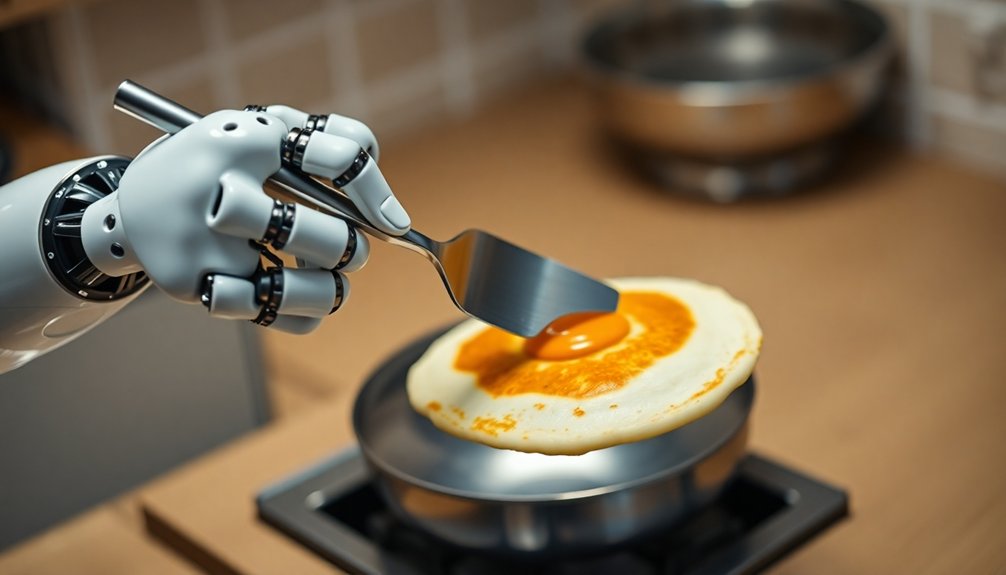
Ever wondered how a robot might slice a tomato without turning it into mush? Our robotic chefs aren’t just fancy kitchen gadgets—they’re precision machines with 35 degrees of finger freedom. Sensor technology from Rosie’s design allows the robot to capture thermal and visual data with unprecedented kitchen-specific precision.
Imagine hands that can grip a delicate whisk or firmly grasp a heavy pot, all while sensing texture and shape through advanced tactile sensors. These aren’t clunky metal appendages, but sophisticated instruments that dance across kitchen surfaces with near-human finesse.
Robotic hands: precision dancers transforming kitchen surfaces with sensor-driven, near-human culinary grace.
Each finger moves independently, synchronized like a culinary ballet, capable of switching from gentle egg-handling to aggressive chopping in milliseconds. The robots can leverage their unified neural network architecture to adapt seamlessly across different kitchen tasks without requiring specific reprogramming for each activity. The secret? Force-position control that mimics human touch, letting robots navigate the chaotic kitchen landscape with surgical accuracy.
It’s not just cooking—it’s technological choreography that blurs the line between machine and masterchef.
Decoding Culinary Complexity Through Machine Learning
While robots might seem like they’re just fancy kitchen appliances, machine learning is transforming them into culinary wizards that can actually understand food beyond mere ingredients. Random Forest models, like those used in recent AI taste prediction research, are helping robots analyze complex flavor profiles with unprecedented accuracy. We’re teaching these mechanical chefs to decode the wild complexity of cooking through smart algorithms that learn from video, user feedback, and massive datasets. Think of it like training a super-smart intern who can watch cooking shows and instantly understand technique. The University of Cambridge and Beko’s research specifically demonstrates how robot chefs learn taste by training a humanoid robot to create perfect omelettes through advanced machine learning techniques.
Machine learning lets robots recognize subtle patterns in recipes, predict taste preferences, and even improvise new dishes. They’re analyzing everything from ingredient interactions to cultural cooking styles.
But here’s the catch: these systems are still learning. They’re not Julia Child yet, but they’re getting closer to turning cooking from a rigid set of instructions into a creative, adaptive process that mimics human intuition.
Sensors, Vision, and the Art of Kitchen Navigation
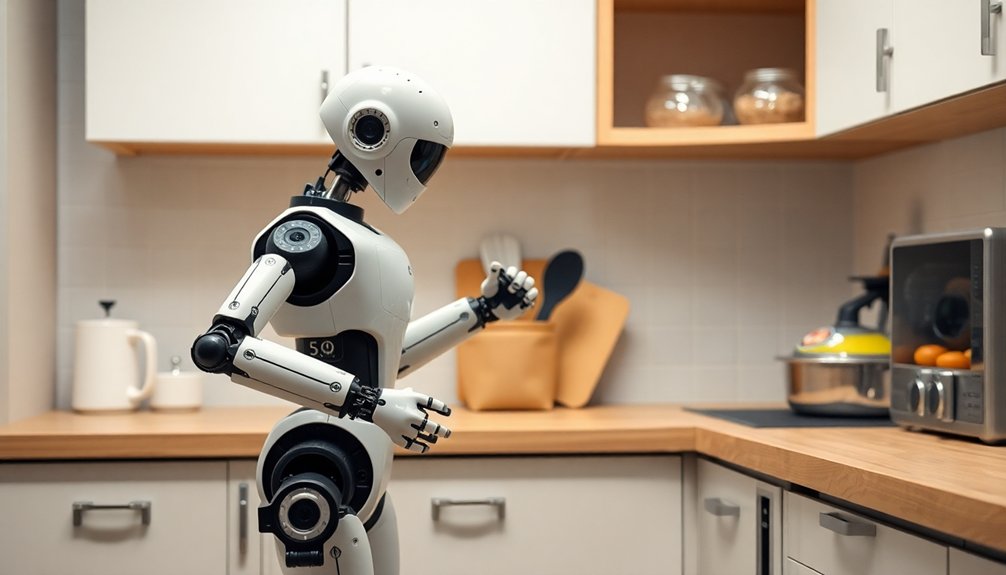
Because cooking isn’t just about tossing ingredients into a pan, our robotic chefs need some seriously smart navigation skills. They’re basically tiny astronauts exploring the culinary galaxy, mapping kitchen terrain with sensors that would make NASA engineers proud. Advanced mmWave radar sensors provide comprehensive 360-degree environmental perception, enabling precise obstacle detection and navigation. The sensor industry’s projected market growth indicates substantial technological potential for increasingly sophisticated robotic capabilities in complex environments like kitchens. Robotic vision systems leverage sophisticated image processing algorithms to interpret and navigate spatial environments with remarkable precision.
| Sensor Type | Kitchen Superpower |
|---|---|
| IMUs | Posture Control |
| Stereo Cameras | Depth Perception |
| Force Sensors | Precise Handling |
Imagine a robot pirouetting around hot stoves, dodging obstacles with laser-like precision. Our mechanical sous chefs use SLAM technology to create real-time kitchen maps, process environmental data faster than you can say “julienne,” and adapt to sudden changes like a culinary ninja. They’re not just following programmed routes; they’re learning, adjusting, and basically turning cooking into a high-stakes robotic dance of intelligence and dexterity.
When Artificial Intelligence Meets Cooking Techniques
From kitchen sensors mapping spatial landscapes, we’re now stepping into the brainy domain where algorithms start cooking—literally.
AI isn’t just crunching numbers; it’s reinventing how we think about food. Moley Robotics’ robot chef can execute precise cooking tasks from 5,000 pre-programmed recipes, demonstrating AI’s potential to transform culinary experiences. Imagine an algorithm that transforms leftovers into gourmet meals or suggests flavor combinations your grandma never dreamed of.
Machine learning isn’t just analyzing recipes—it’s creating them, blending cultural cuisines with nutritional science like a digital culinary maestro. Sustainable food practices are emerging as AI helps reduce food waste by intelligently repurposing ingredients and optimizing resource utilization.
We’re watching AI decode cooking’s secret language, turning historical cooking data into smart, adaptive recipes that adjust to your diet, skill level, and taste preferences.
Who knew algorithms could be such creative chefs? The future of cooking isn’t just technology—it’s a delicious collaboration between human intuition and machine intelligence.
Breaking Down Recipe Comprehension for Robotic Chefs
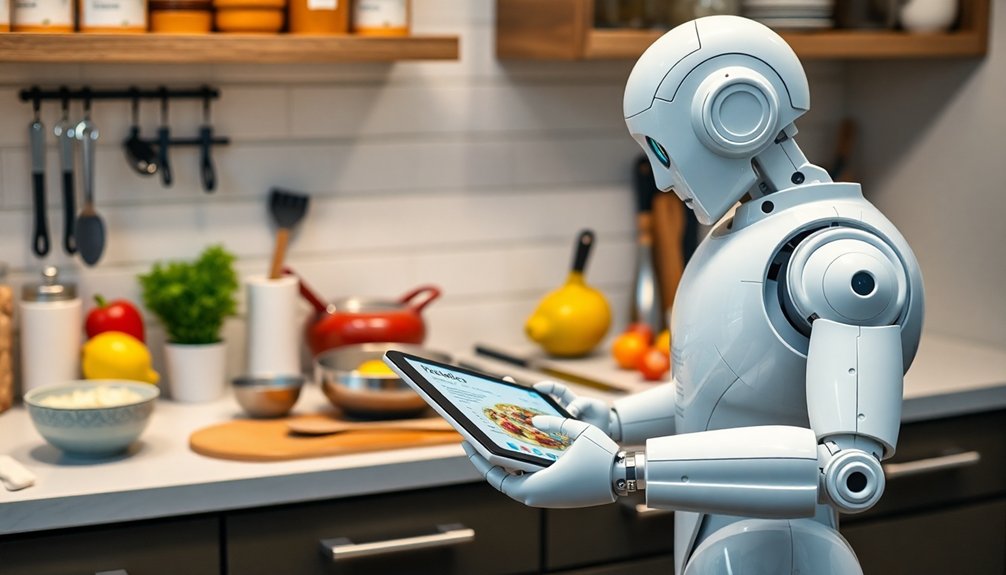
Teaching a robot to cook isn’t just about programming a metallic sous chef—it’s about translating the nuanced language of recipes into precise mechanical actions that can chop, sauté, and season like a culinary genius.
We’re breaking down the complex challenge of recipe comprehension by mapping how AI can decode cooking instructions, analyze ingredient interactions, and predict ideal cooking times with increasing sophistication. By leveraging the kitchen as a semi-structured computational environment, robotic systems can develop advanced perception and manipulation skills through acoustic signal processing that transforms voice commands into precise culinary instructions.
The benchmark for recipe understanding introduced at LREC-COLING 2024 provides a critical framework for testing artificial agents’ ability to comprehend and execute complex culinary tasks.
Imagine a humanoid robot that doesn’t just follow a recipe, but understands the subtle dance of flavors, temperatures, and techniques that transform raw ingredients into a masterpiece.
Recipe Language Decoding
When robots tackle cooking, they face a linguistic maze more complex than your grandma’s secret recipe card. Decoding culinary instructions isn’t just about translating words; it’s about understanding the hidden dance of actions and timing. Robotic vision systems enable machines to more precisely interpret visual cooking cues, bridging the gap between language comprehension and physical execution.
We’ve discovered three key challenges in recipe language:
- Ambiguity Everywhere: Natural language recipes are packed with implicit steps and assumptions that would make a logic professor scratch their head.
- Context is King: Phrases like “dice onions” require an entire universe of assumed knowledge about kitchen tools and techniques.
- Temporal Gymnastics: Sequencing matters – when to stir, when to simmer, when to panic – and robots must learn these subtle choreographies.
Large language models are our translators, converting messy human instructions into precise robotic blueprints.
It’s computational poetry in motion.
Ingredient Interaction Analysis
Because robots aren’t born knowing the secret language of cooking, we’ve got to teach them how ingredients dance together like culinary choreographers. Understanding ingredient interactions is like decoding a complex molecular ballet where chemistry meets creativity. We’re mapping out how different components transform, enhance, and interact during cooking—turning raw materials into edible magic. Neuromorphic computing allows robotic systems to learn and adapt to the intricate nuances of culinary science, much like how advanced surgical robots process complex medical procedures.
| Ingredient Property | Interaction Type | Cooking Impact |
|---|---|---|
| Protein | Structural Change | Texture Transformation |
| Fat | Flavor Carrier | Taste Amplification |
| Acid | Chemical Modifier | Tenderizing Effect |
| Water | Thermal Conductor | Heat Distribution |
| Salt | Molecular Catalyst | Flavor Enhancement |
Our robot chefs are learning that cooking isn’t just following instructions—it’s understanding the intimate molecular conversations happening in every pan, every moment. Who knew teaching a machine to cook could be so deliciously complicated?
Cooking Time Prediction
If robots are going to master the culinary arts, they’ll need more than just a recipe—they’ll need to understand the unpredictable dance of cooking times. Our robotic chefs face a complex challenge in predicting meal preparation:
- Machine learning algorithms analyze kitchen data, turning chaos into precise time estimates.
- Sensors track ingredient interactions, transforming unpredictable cooking moments into quantifiable insights.
- AI models adapt in real-time, learning from each sizzle and simmer.
We’re fundamentally teaching machines to think like distracted home cooks—tracking multiple variables simultaneously while preventing kitchen disasters.
Imagine a robot that can sense when a sauce is about to burn or predict exactly how long that tricky soufflé needs in the oven.
It’s not just cooking; it’s computational gastronomy. The future of food preparation isn’t just about following instructions—it’s about understanding the subtle art of timing.
From YouTube Videos to Culinary Mastery: Robot Learning Strategies
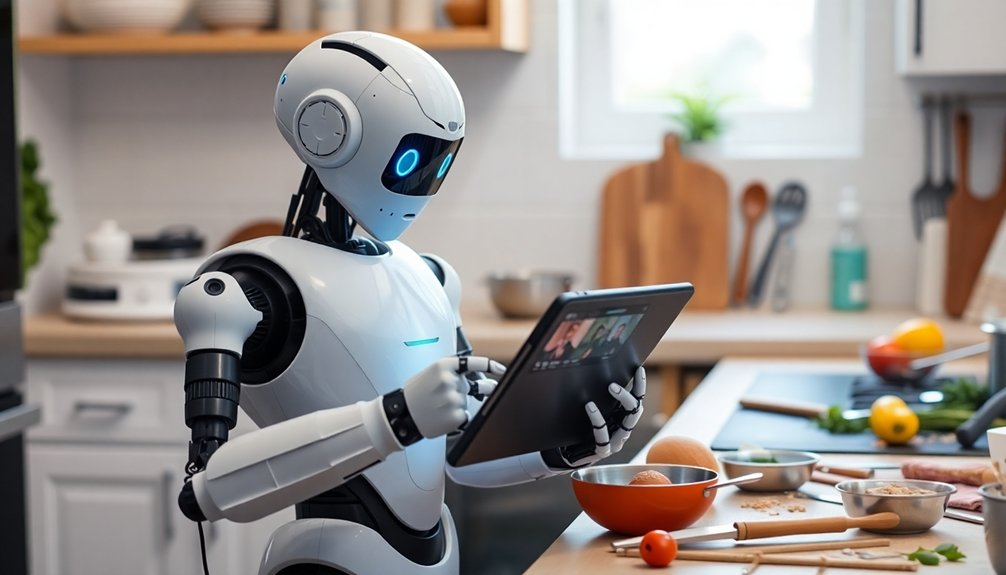
As robots inch closer to culinary competence, YouTube might just become their unexpected cooking school.
Deep learning algorithms now let robots watch cooking videos and extract precise recipe steps, turning random internet content into sophisticated training data. Imagine a robot studying Gordon Ramsay’s technique, learning knife skills and sauce techniques through visual analysis.
These silicon chefs use functional object-oriented networks to map cooking actions, translating human movements into programmable instructions. They’re not just mimicking; they’re understanding underlying principles of cuisine.
Motion embedding and graph search retrieval help robots generalize skills across different recipes and kitchen environments. Who would’ve thought that binge-watching cooking channels could transform a clunky machine into a potential master chef?
The future of cooking isn’t just human anymore—it’s hybrid, algorithmic, and surprisingly delicious.
The Silent Revolution: How Robots Are Transforming Kitchen Dynamics
We’re witnessing a kitchen revolution where robots are quietly transforming how we cook, turning culinary spaces from human-only territories into collaborative tech zones where machines do more than just blend and chop.
Imagine smart robotic systems that can learn recipes from YouTube, precisely execute complex cooking techniques, and potentially replace entire kitchen staff with algorithmic precision.
As automation reshapes our relationship with food preparation, we’re standing at the edge of a technological frontier where humanoid robots aren’t just kitchen assistants, but potential master chefs who never get tired, never make inconsistent meals, and definitely won’t complain about chopping onions.
Culinary Automation Reshapes Kitchens
Here’s what’s really going down:
- AI and machine learning are turning kitchens into smart zones, where robots handle everything from chopping to cooking with precision that makes human chefs look clumsy.
- Automation isn’t just about replacing workers—it’s about solving real problems like labor shortages, reducing waste, and cranking up food safety standards.
- From smart sensors to robotic arms, technology is reshaping how we think about food production, making the impossible suddenly feel inevitable.
The future? It tastes like efficiency—with a side of innovation.
Human-Robot Kitchen Interactions
The kitchen’s robotic revolution isn’t some sci-fi fantasy—it’s happening right now, and it’s reshaping how we think about cooking faster than you can say “sous-chef robot.”
Imagine stepping into a kitchen where mechanical arms slice vegetables with surgical precision, where algorithms predict food prep needs before human hands even reach for a knife.
We’re witnessing a silent transformation where cobots aren’t replacing humans but becoming our collaborative partners. They handle the mundane: chopping, frying, plating.
We bring creativity, supervision, and that ineffable human touch. Safety sensors keep everyone protected, while productivity soars.
Our new skill? Understanding these mechanical teammates, troubleshooting their systems, and guiding their culinary dance.
It’s not about robots taking over—it’s about making kitchens smarter, safer, and more efficient.
Tech Transforms Cooking Dynamics
When robots first crashed the culinary party, most chefs rolled their eyes—but now they’re watching mechanical arms transform kitchens faster than a soufflé rises.
Tech’s culinary coup is reshaping how we think about cooking, driven by some jaw-dropping innovations:
- Collaborative Cobots: These smart machines aren’t replacing humans; they’re becoming kitchen teammates, handling repetitive tasks with precision.
- AI-Powered Perfection: Machine learning algorithms now optimize recipes, portion control, and ingredient selection in ways human chefs could only dream about.
- Efficiency Explosion: Robotic systems can cut labor costs by 50% while maintaining consistent food quality that would make a Michelin-star chef tip their toque.
The future isn’t just automated—it’s deliciously intelligent.
Who knew rocket science would taste so good?
Precision Engineering: Creating Robotic Hands That Can Chop and Stir
Precision engineering transforms robotic hands from clunky metal contraptions into graceful culinary assistants that can slice, dice, and stir with near-human finesse.
We’ve engineered muscle-like anatomies that mimic human movements, packed with advanced sensors that track every delicate ingredient manipulation. Think of these robotic hands as part sous chef, part ninja — capable of handling a 20-pound roast or whisking a fragile soufflé with equal precision.
AI and machine learning aren’t just buzzwords here; they’re the secret sauce making these mechanical marvels smarter with each chop and stir.
By processing real-time sensor data, our robotic hands adapt to different ingredients, cooking techniques, and kitchen challenges.
Who said robots can’t cook? They’re about to make your kitchen look like a sci-fi movie.
Safety Protocols: Preventing Kitchen Catastrophes With Technology
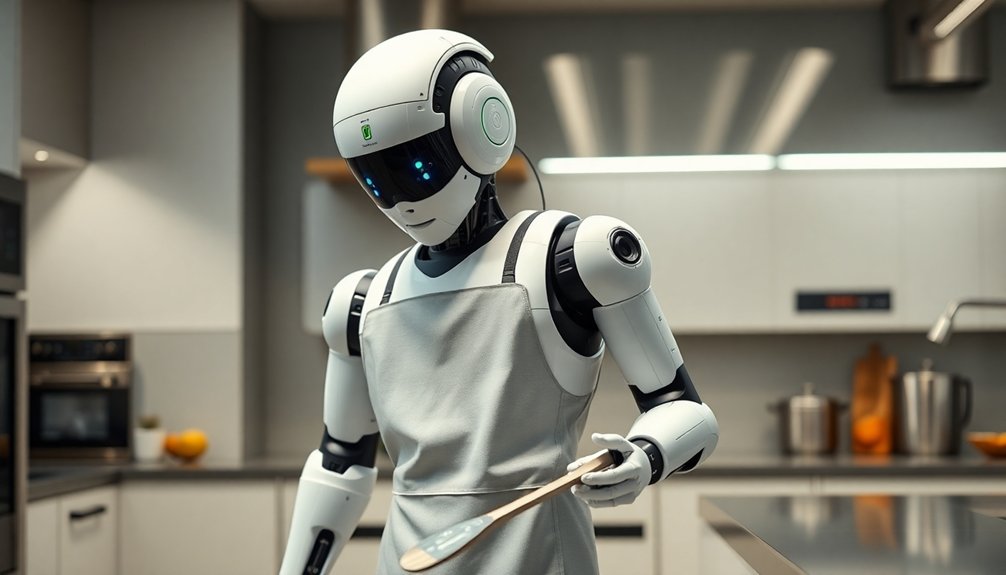
We’ve all seen kitchen disasters unfold—a knife slipping, a hot pan tipping, a distracted cook causing chaos—but what if robotic safety sensors could predict and prevent these potential catastrophes before they happen?
Our humanoid kitchen companions are being engineered with sophisticated hazard detection systems that can instantly recognize risks like unexpected object movements, temperature spikes, or potential collision paths.
Safety Sensor Systems
Modern kitchens are transforming into high-tech safety zones, where intelligent sensor systems stand guard against potential culinary disasters.
These digital sentinels are revolutionizing kitchen safety with superhuman precision:
- Temperature Guardians: Smart sensors monitor refrigerators, cooking stations, and equipment, preventing food spoilage and bacterial growth with laser-like accuracy.
- Hazard Hunters: Gas leak detectors, motion sensors, and overheating prevention systems work like invisible bodyguards, catching risks before they become catastrophes.
- Predictive Protectors: Advanced IoT technology transforms appliances into proactive safety machines, automatically implementing protocols that humans might miss.
We’re witnessing a technological evolution where sensors aren’t just monitoring—they’re predicting, preventing, and protecting.
Imagine kitchens where accidents become relics of a less intelligent past, where technology doesn’t just cook our food, but keeps us safe while doing it.
Robot Hazard Detection
When robots start cooking, they’d better know how to not burn down the kitchen—and that’s where hazard detection becomes less of a tech fantasy and more of a survival skill.
Our mechanical chefs aren’t just chopping ingredients; they’re scanning environments with an arsenal of sensors that would make James Bond jealous. Cameras, infrared, and ultrasonic tech work together like a hyper-vigilant kitchen detective, catching potential disasters before they happen.
Want to know the secret sauce? AI algorithms that learn and adapt, comparing real-time sensor data against pre-stored hazard patterns. If something looks sketchy—a smoking pan, a potential chemical leak—these robots can shut down burners, move dangerous objects, and alert humans faster than you can say “fire extinguisher.”
Safety isn’t just programmed; it’s engineered.
Kitchen Incident Prevention
From detecting robot kitchen hazards to preventing human kitchen disasters, safety isn’t just about avoiding flames—it’s about outsmarting potential mayhem before it strikes.
We’re diving into kitchen incident prevention with tech-powered strategies that make our culinary spaces smarter and safer:
- Smart Sensors: Modern appliances now come equipped with temperature and motion tracking that can predict potential accidents before they happen.
- Automated Monitoring: Advanced systems continuously scan cooking environments, alerting users to risks like unattended stovetops or overheating surfaces.
- Data-Driven Safety: By analyzing past kitchen incidents, we’re developing predictive technologies that learn from human error.
Think of it like training a hyper-intelligent sous chef who never sleeps, never gets distracted, and whose sole mission is keeping you from turning your kitchen into a disaster zone.
Genius, right?
Cultural Implications of Robots Entering the Culinary World

As robots inch closer to mastering the art of cooking, we’re facing a culinary revolution that goes way beyond just swapping spatulas for mechanical arms.
Our kitchen futures are complex: these machines might preserve generations-old recipes while simultaneously threatening cultural authenticity.
Imagine a robot perfectly replicating your grandmother’s secret sauce, but with zero emotional connection.
We’re traversing tricky terrain where technology could homogenize global cuisines or spark unprecedented culinary creativity.
Will robot chefs become cultural translators or cultural erasers? The stakes are high.
Food isn’t just sustenance; it’s memory, tradition, and identity.
We’re standing at a crossroads where precision meets passion, where algorithms could either celebrate diversity or flatten it into something unrecognizably generic.
The robot revolution isn’t coming—it’s already simmering.
Economic Disruption and Opportunities in Robotic Cooking
Because robots are about to turn the restaurant industry upside down, we’re looking at an economic earthquake that’ll make the gig economy look like a mild tremor.
The future of cooking isn’t just about machines—it’s a total financial reboot:
- Food robots can slice labor costs by 75%, replacing $9,000/month human servers with $350/month mechanical chefs.
- Robotic kitchens operate 24/7 without breaks, sick days, or attitude problems.
- Automation isn’t just cutting jobs; it’s creating a whole new service ecosystem.
We’re witnessing the rise of an economic model where precision meets profit.
Restaurants aren’t just adopting robots; they’re reimagining entire business strategies.
The math is brutally simple: fewer human errors, lower overhead, and consistently perfect meals.
Who wouldn’t want a kitchen that never sleeps, never complains, and always delivers?
Future Horizons: Where Robotics and Gastronomy Converge
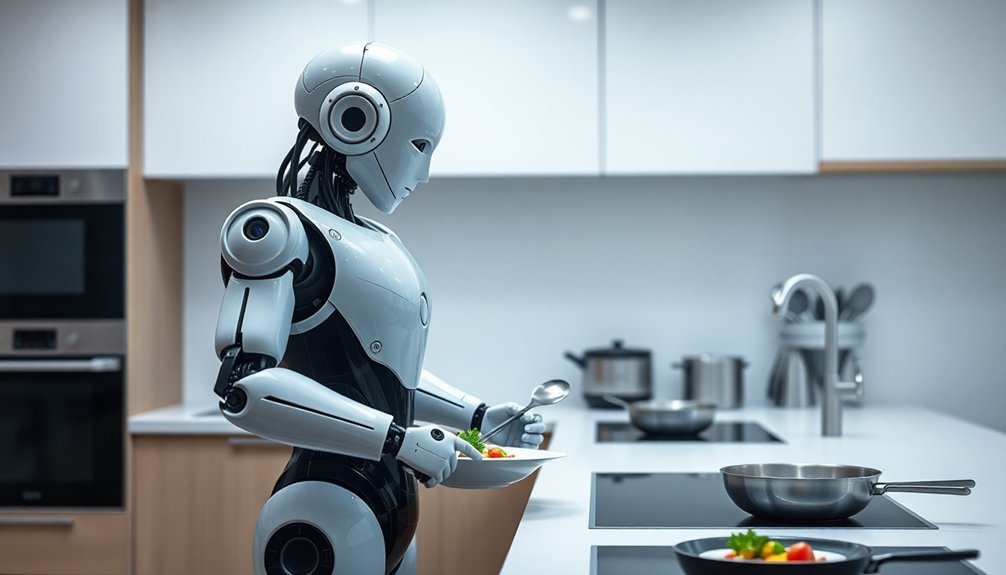
The robot revolution isn’t just coming to kitchens—it’s already cooking. Imagine humanoid chefs slicing, dicing, and creating culinary magic with precision that’d make Gordon Ramsay raise an eyebrow. We’re witnessing a gastronomic transformation where AI meets apron, and the results are deliciously mind-blowing.
| Capability | Robot Performance |
|---|---|
| Speed | 40 portions/hour |
| Precision | Muscle-like movements |
| Safety | Minimal human contact |
| Learning | Continuous adaptation |
| Innovation | New recipe generation |
But let’s be real—these aren’t your grandma’s kitchen helpers. They’re advanced machines learning to replicate human techniques, reducing waste, and potentially revolutionizing how we think about food preparation. Will they replace human chefs? Probably not. Will they make cooking faster, safer, and more innovative? Absolutely. The future of food is robotic, and we’re here for the tasty ride.
People Also Ask
Can a Cooking Robot Tell the Difference Between Salt and Sugar?
We’re developing robotic chemical sensors that can distinguish between salt and sugar by detecting their unique electrochemical properties, allowing cooking robots to accurately identify and differentiate ingredients during food preparation.
Do Robots Experience “Taste” the Same Way Humans Do?
No, robots don’t experience taste like we do. They rely on sensors and algorithms to detect chemical components, lacking the nuanced, multi-sensory perception humans enjoy through taste buds, smell, and personal experience.
How Expensive Are Humanoid Cooking Robots for Home Use?
Like culinary astronauts exploring an uncharted kitchen galaxy, we’ve found humanoid cooking robots are astronomical investments. Current models range from $1,500 to $30,000, with most high-end options hovering around $10,000 – making them a luxury, not a household staple.
What Happens if a Cooking Robot Malfunctions Mid-Recipe?
We’d likely face recipe restart, ingredient waste, and potential safety risks. Our robot might stop mid-cooking, requiring manual intervention to prevent overheating, fire hazards, or complete meal ruination.
Will Robots Eventually Replace Professional Chefs Completely?
Like chefs dancing with culinary algorithms, we don’t believe robots will fully replace professional chefs. They’ll complement human creativity, enhancing kitchen efficiency while preserving the emotional artistry that only skilled human hands can deliver.
The Bottom Line
We’re betting robots will transform kitchens faster than you can flip a pancake. By 2030, the culinary robotics market could hit $4.5 billion—that’s not just spare change. These silicon chefs aren’t replacing human creativity; they’re expanding what’s possible. Imagine precision cooking without human error, learning recipes across global cuisines, and creating dining experiences we can’t even dream of yet. The kitchen revolution isn’t coming—it’s already simmering.
References
- https://singularityhub.com/2024/09/03/robots-are-coming-to-the-kitchen-what-that-could-mean-for-society-and-culture/
- https://www.iotworldtoday.com/robotics/humanoid-robot-uses-chatgpt-to-cook-clean-guard-home
- https://robotics.umd.edu/news/story/robots-learn-kitchen-skills-by-watching-youtube-videos
- http://howtorobot.com/expert-insight/cooking-robots-revolutionizing-modern-kitchen
- https://mikekalil.com/blog/star1-ai-robot-chopsticks/
- https://www.therobotreport.com/figure-humanoid-robots-demonstrate-helix-model-household-chores/
- https://robotsguide.com/robots/rosie
- https://www.rdworldonline.com/say-goodbye-to-chores-the-helix-robot-demonstrate-a-new-level-of-dexterity-in-handling-everyday-objects/
- https://deepmind.google/discover/blog/advances-in-robot-dexterity/
- https://www.unitree.com/g1
